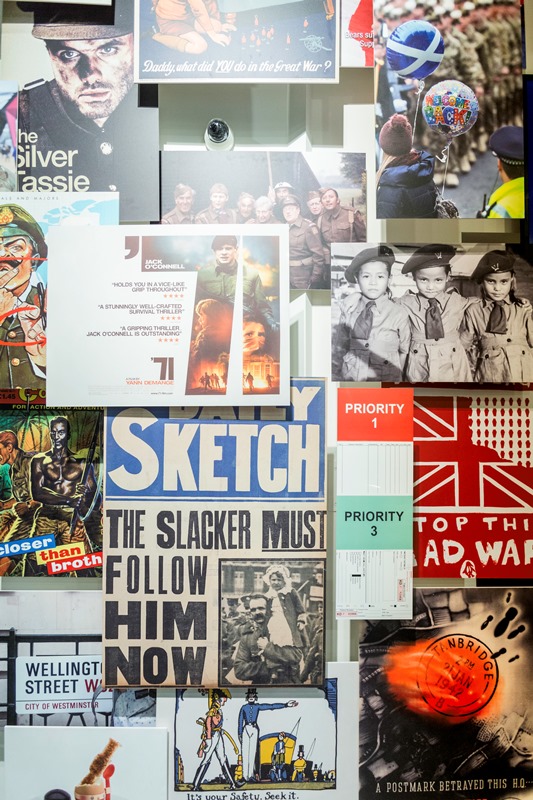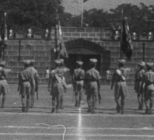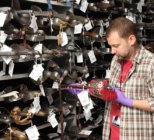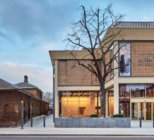The National Army Museum (NAM) in Chelsea has undergone a complete transformation to maximise access to, and engagement with, its collection. The aim of the refreshed museum is to better bridge the gap between the British Army and society and encourage greater public engagement through thought-provoking displays.
Built in 1971, the museum building has been reconfigured with architects BDP and design agency Event, with the concrete wall along the ground floor replaced by big glass windows to create a more welcoming, accessible and flexible environment. The museum hopes it can now increase its visitor figures from 340,000 in the first year after reopening to 400,000 by 2026.
The bright new building will tell the story of the army from the 1640s (when the collection starts) and include over 2,500 objects in five permanent thematic galleries, laid out over four floors as well as a 500m sq temporary exhibition space, a study centre, a three-room learning centre, as well as a brand new café, shop and play base, where children aged zero to seven can learn through play.
“Our main aim has been to open up the museum to a wider audience and design a building and galleries that can accommodate more visitors and show more of our collection than was possible before we closed,” says Director Janice Murray. “We wanted to be able to tell the story of the British Army in a welcoming environment and to be able to continue to expand our collection to do so. We were also aware that before closure the building could not cope with a larger number of visitors so we have created a larger, more open and welcoming space.”
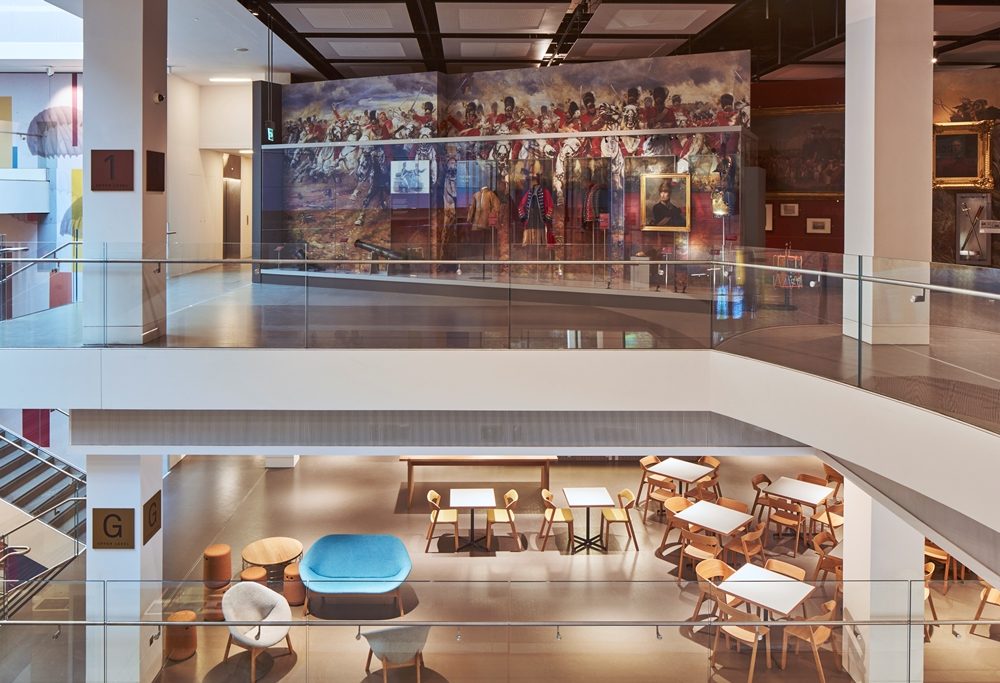
As part of its transformation, Murray says the museum has expanded its public programmes offer looking at contemporary topics including women fighting on the frontline, the Chilcot enquiry and Brexit as well as historical events from Indian Independence to Passchendaele. The re-development project has also given the museum the opportunity to look at its brand, which has been redesigned, and the values of its visitors.
“We have been able to collect a lot of contemporary material throughout our closure making sure that our displays include items from only last year. We have also been able to acquire items such as Lawrence of Arabia’s robes and dagger.”
An army of volunteers, as reported in Advisor, has been assisting with the transformation and, as Murray says, with its workforce the museum has been able to offer apprenticeships and traineeships while offering current staff members the opportunity to attend courses and conferences to help develop their skills.
The first gallery that visitors will enter as they move through the museum is Soldier, which is full of individual stories contained within the National Army Museum’s collections and archive. The gallery will follow the life of a soldier from joining the army to training and daily life, and the reality of crime and punishment, to exploring both combat and non-combat roles and finally coming home. Visitors can engage with a series of tests to find out if they could become a soldier and can be drilled in marching. Objects on display within the gallery include Crimean Tom, a cat found during the Crimean War and brought back to Britain as a pet; the Welsh flag which formed part of the memorial of a soldier who was wounded in Afghanistan in 2009 and later died in hospital; and James McGuire’s Victoria Cross, which he received for gallantry during the Indian Mutiny but lost when he was convicted of stealing his uncle’s cow.
Following McGuire’s fall from grace, visitors will encounter the Army gallery, which charts the history of the army as an institution, and explores its origins in the chaos of the British Civil Wars, (such as the Flag of Gells Regiment) its major role in the political development of the country onto its impact on global history. Finally the gallery looks at how the British Army tries to remain relevant through technological and social change including the change in modern recruitment posters. In the Army gallery there are new huge display cases of uniforms that visitors can walk around and see the whole of the detail, unlike previously when the old cabinets only showed the front of the uniforms.

The army’s tactic will then be the focus of the Battle gallery as it explores the British experience of battle from the 1640s to the present day. Throughout this period tactics evolved in the light of technological development and became a major determinant of victory in battle. However, when tactics did not keep up with the technological development such as the machine gun, the scale of casualties became horrific. Visitors will be able to experience some of these technological developments through interactives such as driving a tank or drumming a battle command. The Battle of Waterloo will be brought to life with a new multimedia interpretation of the Siborne Model that enables visitors to investigate both the model and the famous battle.
Possibly the most eagerly awaited galleries in the new museum is the Society gallery, which opens up a new topic of conversation not tackled in depth before at the museum, where objects and stories are brought together to examine the army as a cultural as well as a military force. The gallery looks at the army’s impact on the country’s customs, values and choices, from the toys (Action Man) and music (Jimi Hendrix by Gered Mankowitz) to the way the public votes, underpinned by the real experiences of both civilians and soldiers.
“We have introduced a chrono-thematic arrangement layout that allows us to tell more personal stories,” says Emma Mawdsley – senior research curator and curator of the Society Gallery and temporary exhibition space. “It lets us explain the moments of change and the continuity over the ages. So as a result it makes it more accessible museum in that you don’t have to come with as much prior knowledge as you used to.”
The Society gallery has 485 objects on display, which roughly two thirds has been acquired since 2013. A lot of these objects are ephemera, such as charity badges going back to the First World War that people would not have thought important enough to give to the museum in the past. It looks at themes such as the army in fashion (Burberry Trench Coat), fiction (War Horse) and journalism (Kate Adie’s Flak Jacket, helmet, identity discs and press pass), and at its impact on medicine, technology and benevolence, the army is revealed as recognisable and distant, loved and loathed. The gallery also examines moments when communities have encountered British soldiers in circumstances of conflict, natural disaster and national security.
“In the past the museum was purely chronological, so you would start at the bottom of the building and you had different galleries covering different periods of history and you would work your way up to the modern period and we kept running out of space because we couldn’t extend upwards. It also meant that you couldn’t then draw particular themes across the exhibitions. You couldn’t say ‘let’s show how the life of a soldier would change’,” says Mawdsley, who has been assisted by former NAM volunteer and now permanent curator Rebecca Newell.
“Having a thematic approach we can now draw these threads across the museum and it has also given us the chance to have more thought-provoking displays where we pick out things such as ethics. And we can tell those stories more completely because we can tell them across all the periods.”
As well as Society’s new material, other objects already in the collection have never been shown before. The museum has bought, acquired and been donated items to fill gaps in order for Mawdsley and her colleagues to tell the army’s story and in the case of the Society gallery, a story which they haven’t told before.
“Before we had never explored the interaction between the army and society and with less contact between the two these days it’s very important to draw out those links that people aren’t aware of that are still there,” she says. “In Society we talk about lighter subjects such as how language has been impacted by the army and its presence around the world and brought words back from countries where the soldiers have been operating in such as pyjamas and bungalow. And also sayings that have become part of our everyday life.”
However, Mawdsley points out that the Society gallery, along with the other galleries, does not shy away from the more difficult subjects such as newspaper censorship and how that’s changed over time, poppies and their misappropriation by groups such as the English Defence League, veterans’ care, peace protests and the presence of the British Army on the streets of Northern Ireland during the Troubles.
“We do not shy away from controversy in any areas we discuss but try and give a breadth of views. We have also interviewed people so their stories are heard such as Stop the War Coalition and journalists to give lots of different perspectives.” Visitors will find information about soldiers’ sexual conquests, drinking, drug abuse and PTSD; brain injury and death and loss. In the Battle Gallery, still controversial periods in the army’s history are examined such as insurrections including the Mau Mau Uprising and historic events such as the Sultan of Mysore’s two children being kidnapped to make sure that he kept a peace treaty.
“It’s very much about posing the questions and giving people the chance to discuss them. All the galleries in some form or other contain controversial topics. In the Soldier gallery there are lots of interviews and material concerning Richard Stokes, who was the first black Guardsman and he talks about how bananas were thrown at him.”
The galleries also look at how attitudes to soldiers keep changing over time. There have been periods in the past, says Mawdsley, when soldiers have been seen as scum of the earth and there are times when they have been seen as heroes and this changes according to different external factors and that doesn’t necessarily match attitudes to conflict. “Today soldiers are held in high esteem but conflict is not.”

The fifth and final gallery is the Insight gallery, which examines the impact the British Army has had around the world. It explains how no other army has seen service in so many different countries or interacted with such a huge range of peoples and cultures. Intended as a regularly changing exhibition, the gallery’s opening displays look at the army’s connection with Germany, Scotland, the Punjab, Ghana and Sudan. Communities from these areas have been involved in the creation of the gallery, sharing thoughts on their relationship with Britain, the army and the objects within the Museum’s collection, such as a Nazi Car Pennant and a cup from the 1745 Jacobite Rebellion.
As part of the redevelopment a new temporary exhibition space has been created and its first exhibition, entitled War Paint: Brushes with Conflict, explores the fascinating, longstanding relationship between art and the army. More than 130 paintings and objects open up the complex relationship between war and the men and women who map, record, celebrate and document it.
“For a number of reasons we have decided to go with an art exhibition as we used to have an art gallery and there a lot of really important paintings in the collection that hadn’t been used in the permanent galleries. The exhibition is called War Paint and we discuss why people have painted war in the past (people have always painted war since the earliest time) and it’s something that still happens today, even though we have photography and film. In the gallery I try and use a lot of the artists’ voices to explain why they paint and what they paint.”
The exhibition will run until the autumn when the space will close over the winter for commercial and revenue-generating hire, then open up again in 2018 with a new public exhibition.
NAM’s redevelopment was born out of the need for a new entrance but grew into a much more comprehensive project that offers a new dynamism to the museum and ensures the story of the British Army continues to be told in a varied and insightful way.
Main Image
National Army Museum, London. Courtesy of the National Army Museum 2017. Photographer Paul Raftery


